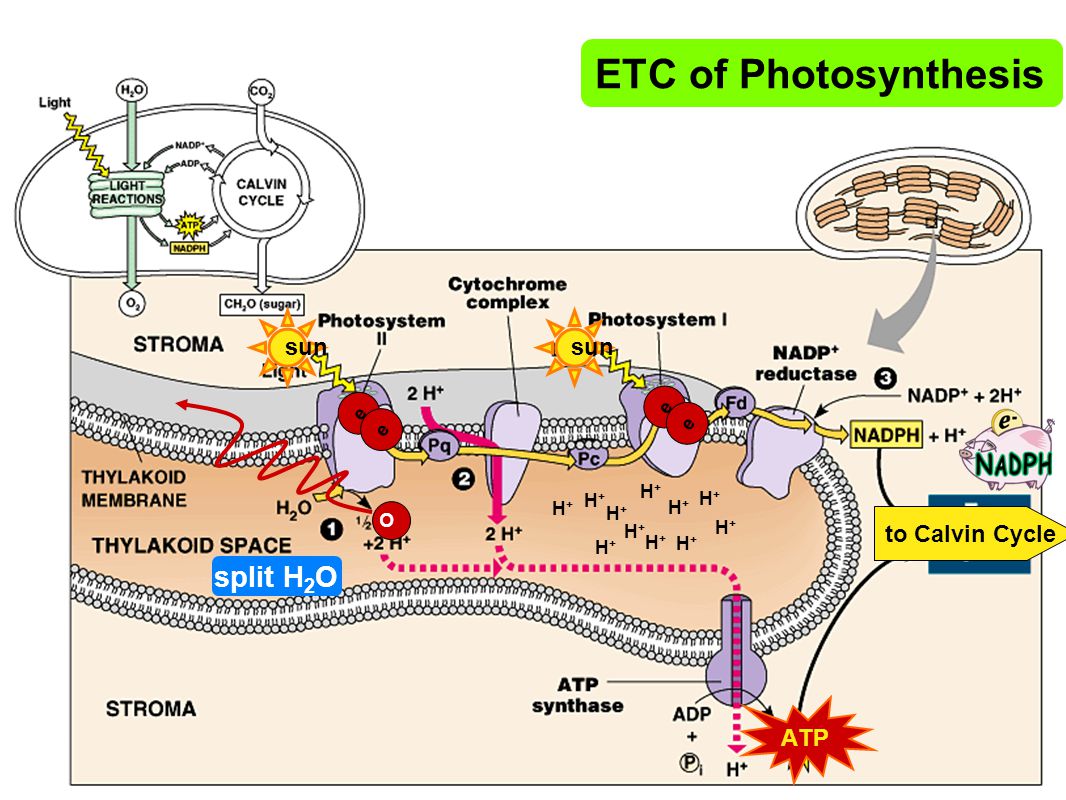<< Hide Menu
Caroline Koffke
Haseung Jun
Caroline Koffke
Haseung Jun
Skills you’ll gain in this topic:
- Describe the stages of photosynthesis, including light-dependent reactions and the Calvin cycle.
- Explain how pigments like chlorophyll capture and use light energy.
- Relate glucose and oxygen production to photosynthetic processes.
- Illustrate photosynthesis’s role in energy cycling within ecosystems.
- Predict how environmental factors affect photosynthesis rates.
Converting Light to Chemical Energy
Photosynthesis is a chemical process with the following equation: H2O + CO2 → C6H12O6 + O2.
Both plants and photosynthetic bacteria are capable of this complex conversion process. The overall reaction is spurred by the energy from a photon of light striking a pigment in the chloroplast. It is thought that photosynthesis first evolved in prokaryotic cells.
Photosynthesis is broken down into two major steps which are dependent on one another: light-dependent reactions and light-independent reactions (Calvin Cycle). Both of these processes occur in the chloroplast of a photosynthetic organism.

Image courtesy of WikiMedia Commons.
Chloroplast
Light-dependent reactions occur in the thylakoid membranes of the chloroplast. These are the “pancakes” of the chloroplast, as they look like a stack of flattened disks. The thylakoid membranes possess important pigments called chlorophyll. This pigment has electrons in it that are excited when energy is input by a photon of light. There are many pigments, but for photosynthesis, we'll focus more on chlorophyll, the main one.

Image courtesy of WikiMedia Commons.
When light strikes the chloroplast, an electron from a molecule of chlorophyll is excited and travels through the electron transport chain. In the process, a concentration gradient of hydrogen ions is formed. This will be used later to produce ATP through ATP synthase. The electron lost from chlorophyll is replaced by an electron from water. This creates more hydrogen ions and the production of oxygen, which is released from the plant.
Light-Dependent Reactions (Electron Transport Chain)
When light hits the pigments, it'll hit Photosystem II first, which is embedded in the internal membrane of the chloroplast and excites electrons. This causes H+ ions to move into the thylakoid space and to replenish electrons, the light splits water, called photolysis, into two H+ ions and 1/2 of O2 and electrons, which replaces the missing electrons in Photosystem II. Why are the electrons missing then? Well, it's because the electrons continue to jump down the thylakoid membrane, bumping into Photosystem I, and thus leaving Photosystem II. With the electrons going down the thylakoid membrane, hydrogen ions continue to be pumped into the membrane.
Because there a lot of hydrogen ions inside the thylakoid space, it's natural for the H+ ions to want to leave the thylakoid space. But the only way for these ions to leave is to go through a transport protein called ATP (adenosine triphosphate) synthase, where ADP (adenosine diphosphate) is phosphorylated (add another phosphate) when H+ goes through it.
Other electrons from Photosystem I bind to an electron carrier, such as NADPH. Electron carriers transport electrons in the form of a hydrogen ion. These electrons can then be used in other processes. In this case, the electrons will be used to form bonds in the Calvin Cycle.

Image courtesy of Giphy.
The ATP and electron carriers produced during the light-dependent reactions are essential to the production of glucose in the light-independent reactions. The production of oxygen is toxic to the plants but provides the rest of the world with the opportunity to breathe.
Light-Independent Reactions (Calvin Cycle)
The light-independent reactions are named due to the fact that they do not require light in order to proceed. This set of reactions is also referred to as the Calvin Cycle. These reactions take place in the stroma of the chloroplast, or the gooey space in between the thylakoid pancakes. With the help of ATP and NADPH, CO2 is turned into sugar.
In the Calvin Cycle, carbon dioxide is converted into an organic carbon source, most often modeled by glucose. The first step of this reaction involves the enzyme ribulose bisphosphate carboxylase, abbreviated as rubisco. This enzyme is responsible for carbon fixation, taking carbon dioxide from the air and converting it into an organic, usable form.
After carbon dioxide has been fixed, the process begins to convert it into glucose. This involves the creation of a lot of bonds. In order to make bonds, electrons and energy are required. This is where the electron carriers and ATP from the light-dependent reactions come into play.
By using the energy from ATP and the electrons from the electron carriers, a number of enzymes are able to convert organic carbon into glyceraldehyde-3-phosphate, or G3P. G3P is a precursor for a number of carbohydrates such as starch, cellulose, and glucose. The cell can use this to create a number of important energy and structural components.

Image courtesy of WikiMedia Commons.
Also important, the ATP that is used is broken down into ADP and a phosphate group which can be recycled and rebonded in the light-dependent reactions. Similarly, the electron carrier NADPH becomes NADP+ after dropping off the hydrogen. This can then be refilled with an electron in the light-dependent reactions.
Summary
Photosynthesis is hard to understand and visualize, but it's an important part of the AP curriculum. Study tips include trying to draw out the process yourself and explain it to a friend or yourself.

Image Courtesy of Slide Player
Understanding the Electron Transport Chain can be the most challenging, so really make sure you understand what causes what. Remember, the sole purpose of photosynthesis is creating sugar. Also, NADPH represents a "loaded dumptruck" with electrons.
| Stage | Location | Input | Output |
| Light-Dependent | Thylakoid membrane, Photosystem I, Photosystem II | Excited electrons, H2O | NADPH, ATP, O2 |
| Light-Independent | Stroma | 3 CO2, 9 ATP, 6 NADPH | sugar |

© 2024 Fiveable Inc. All rights reserved.